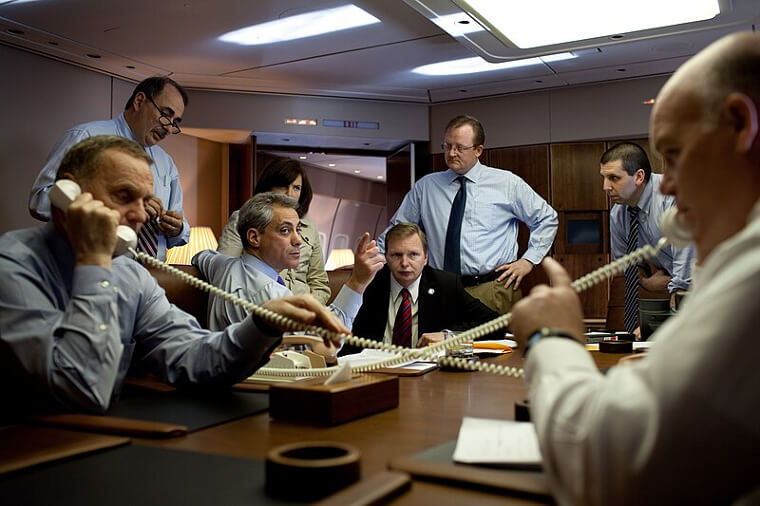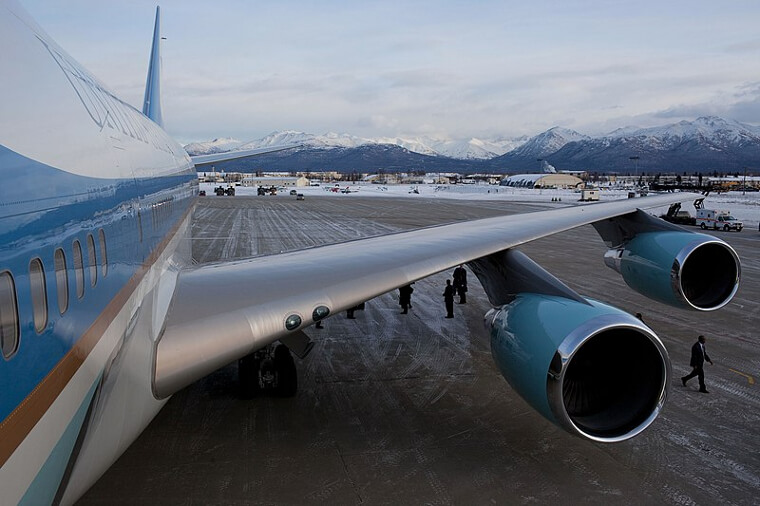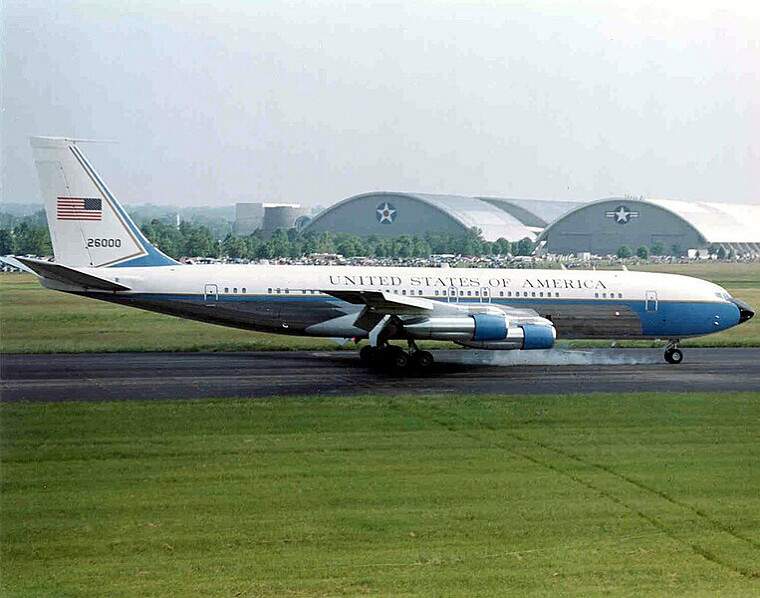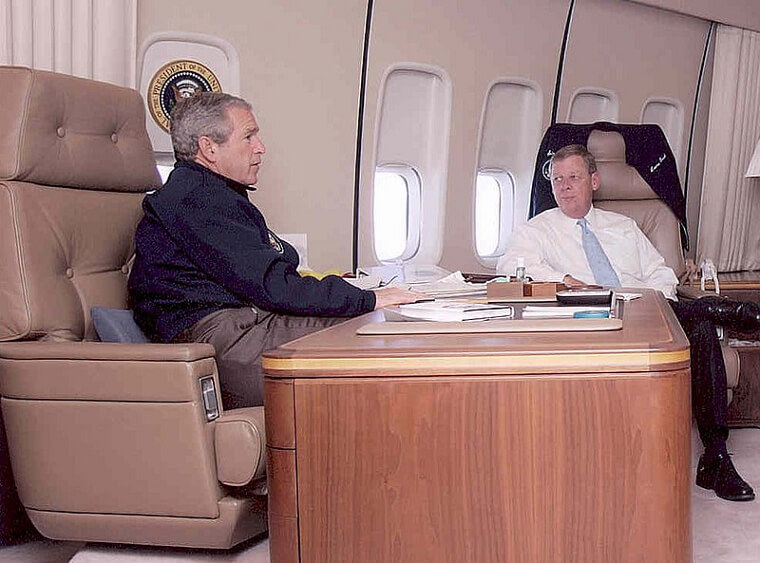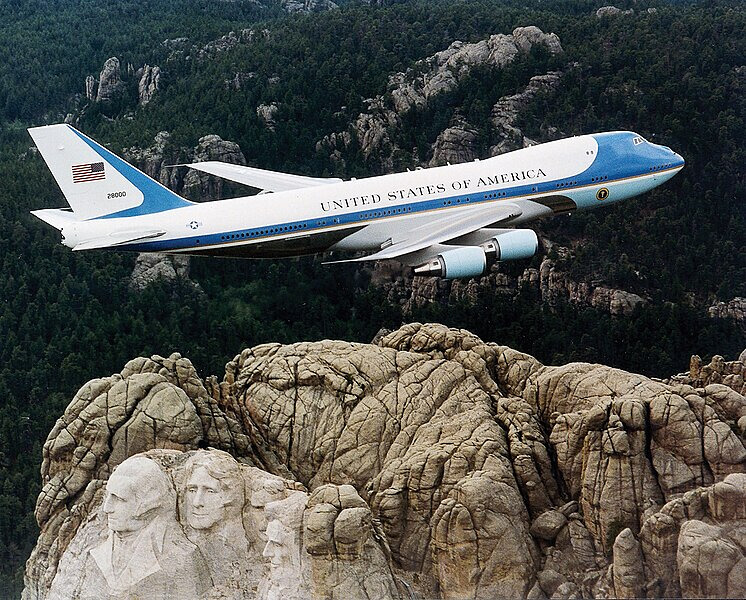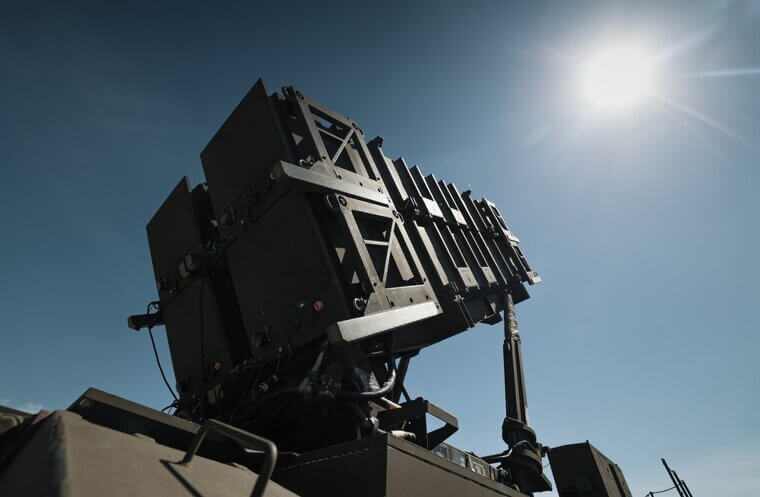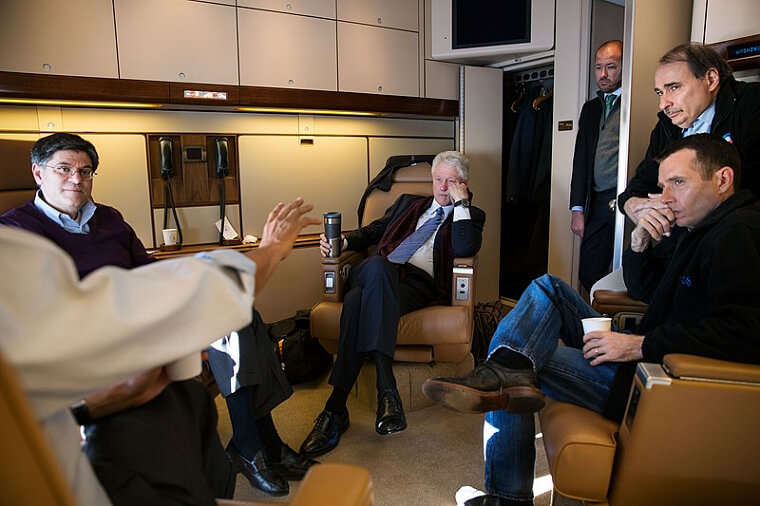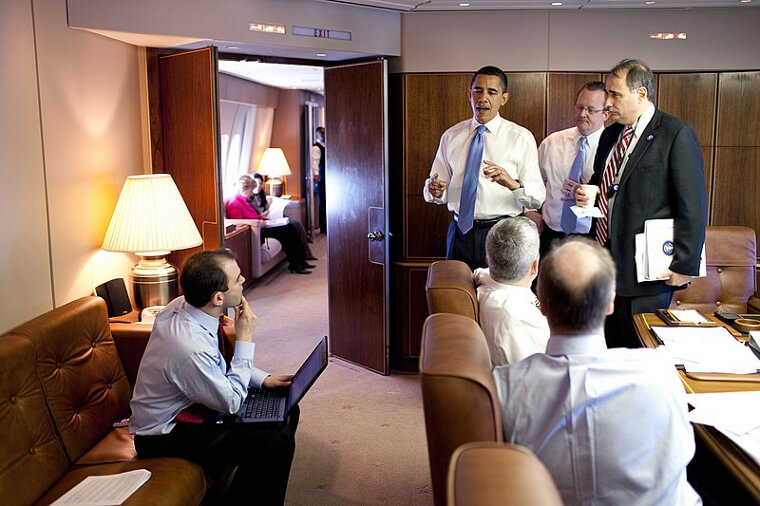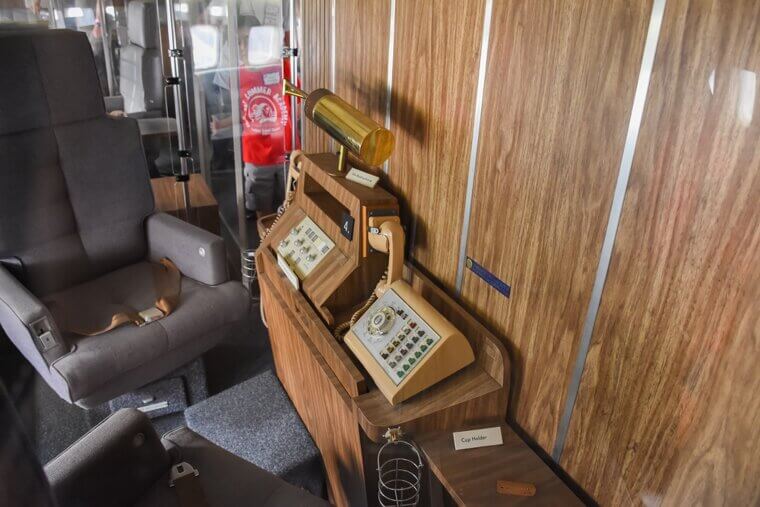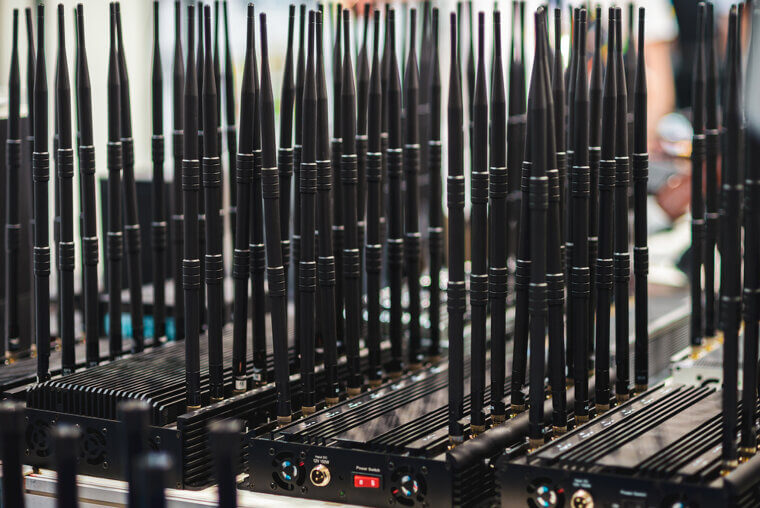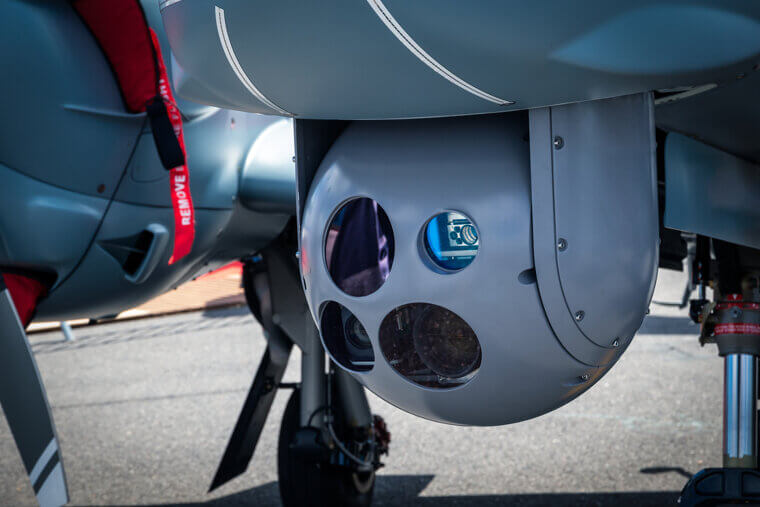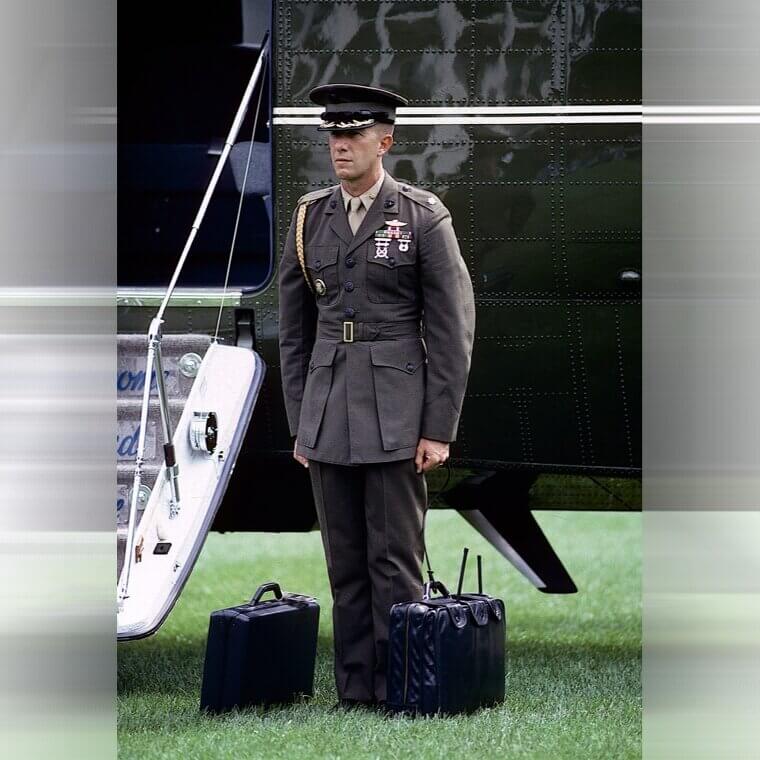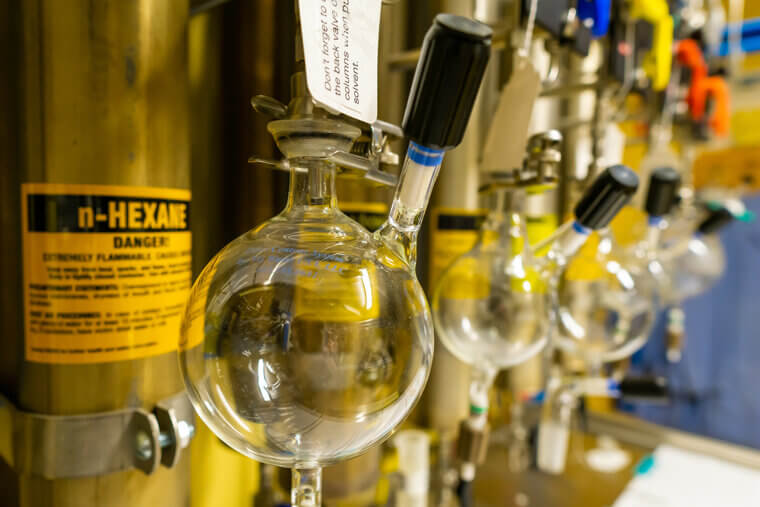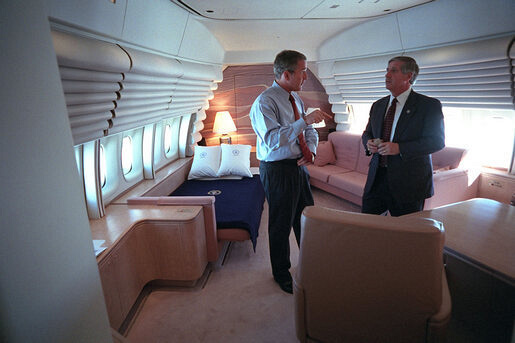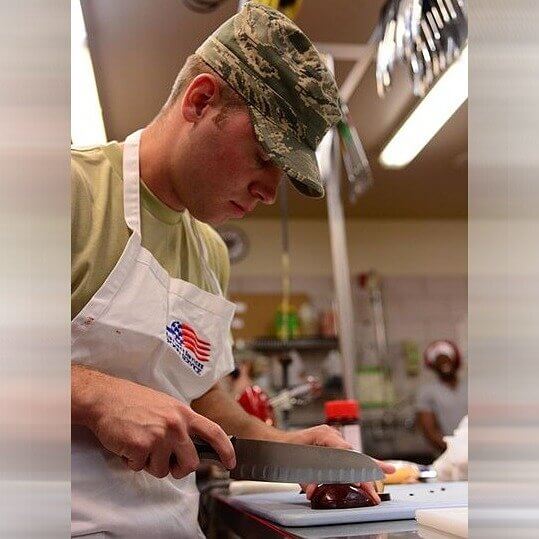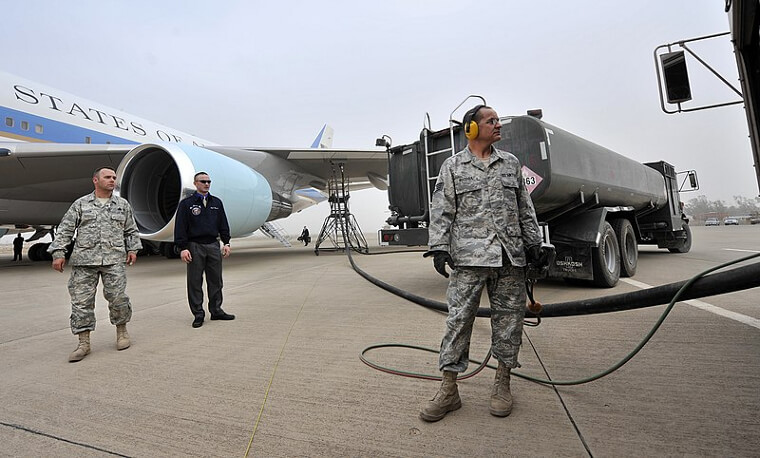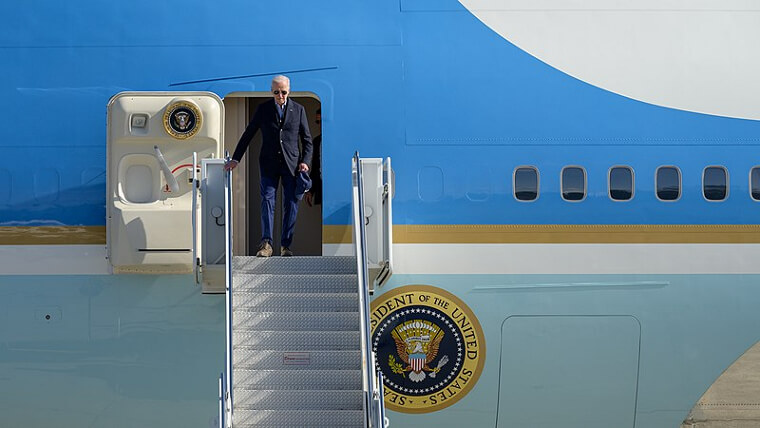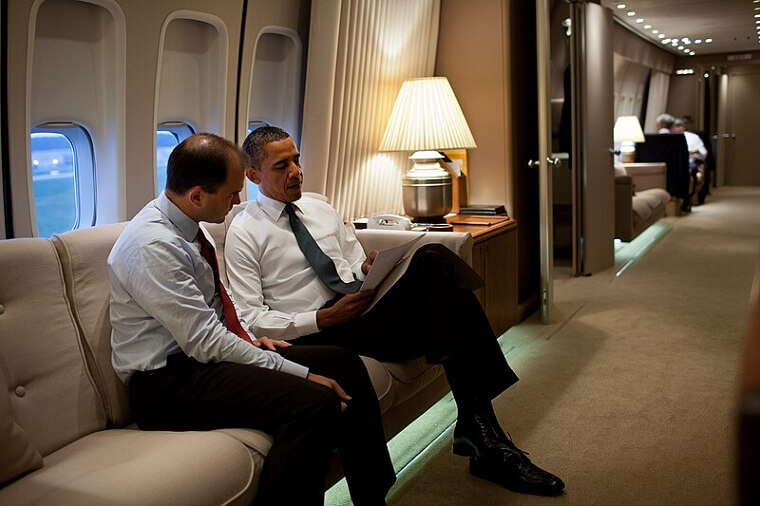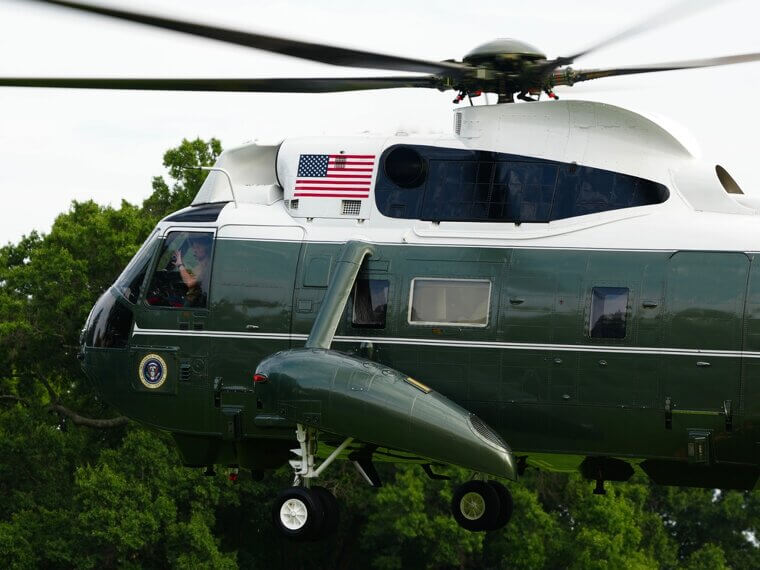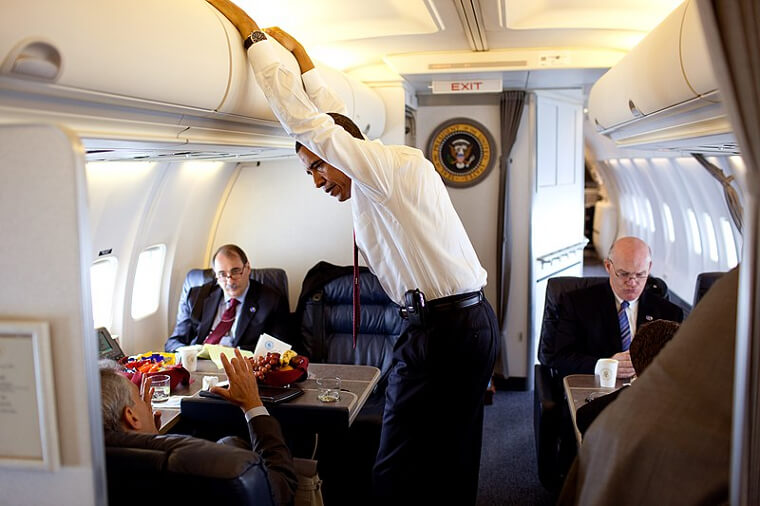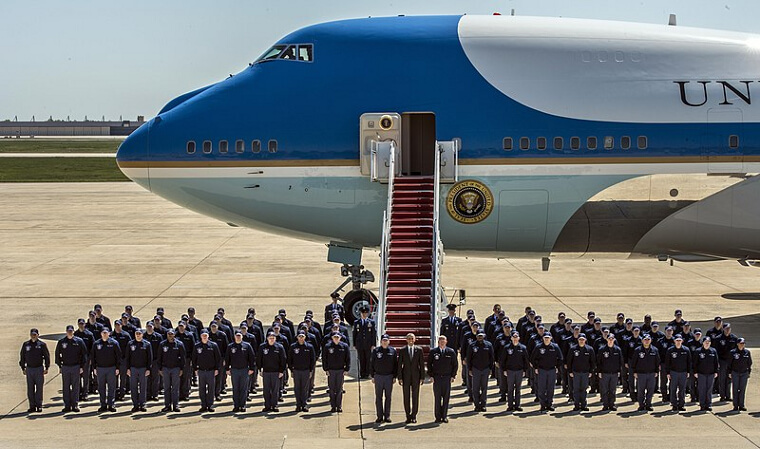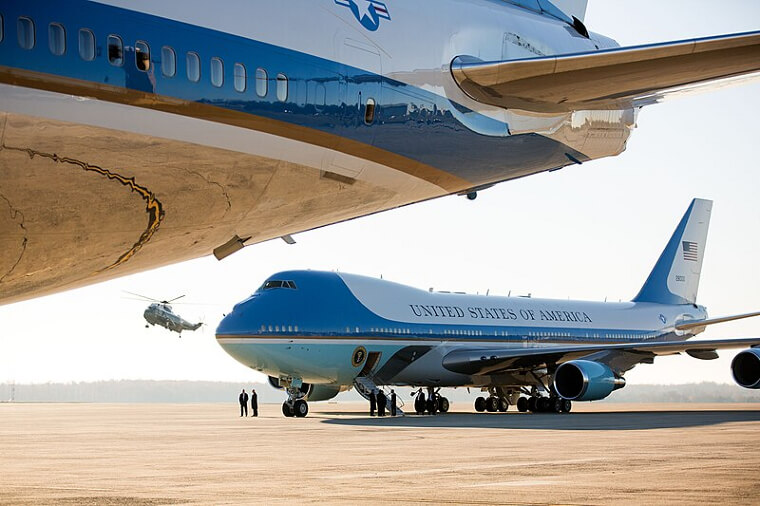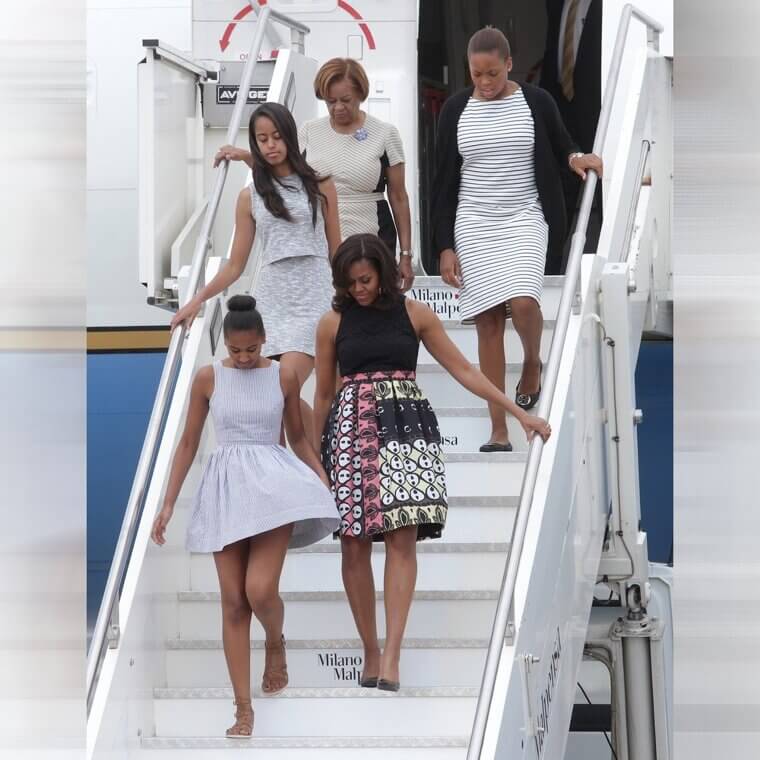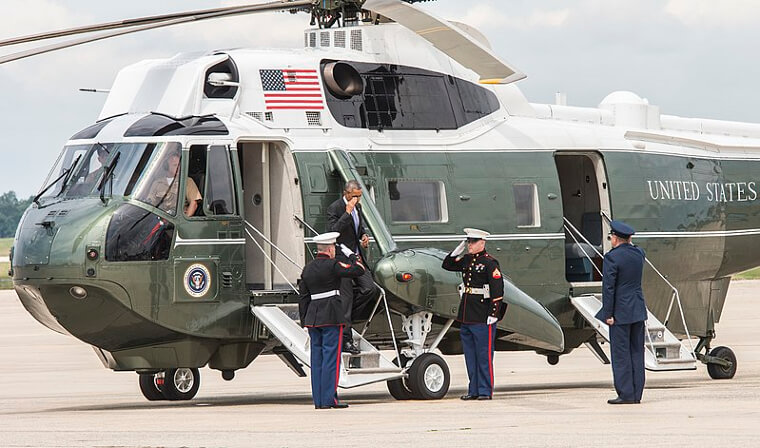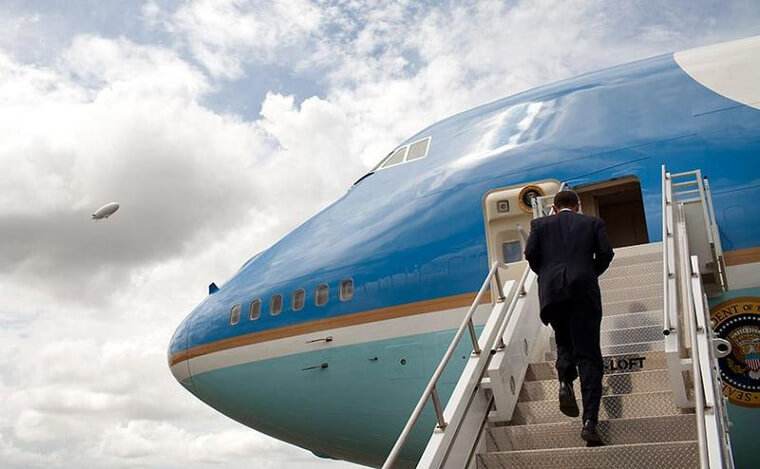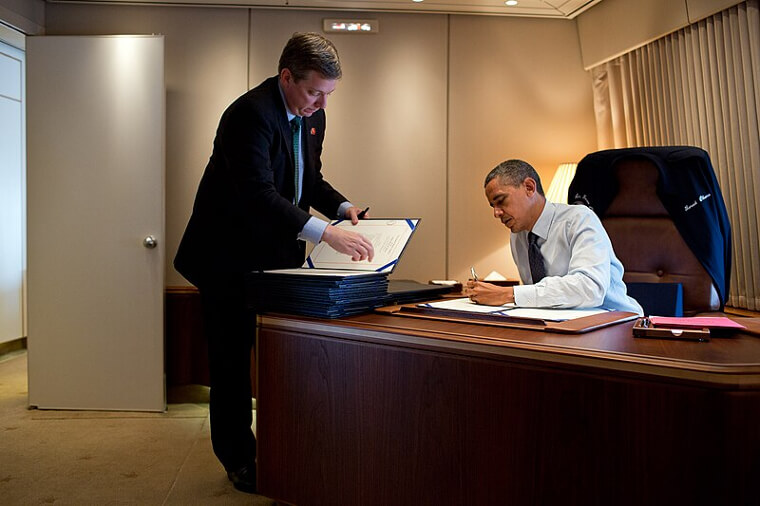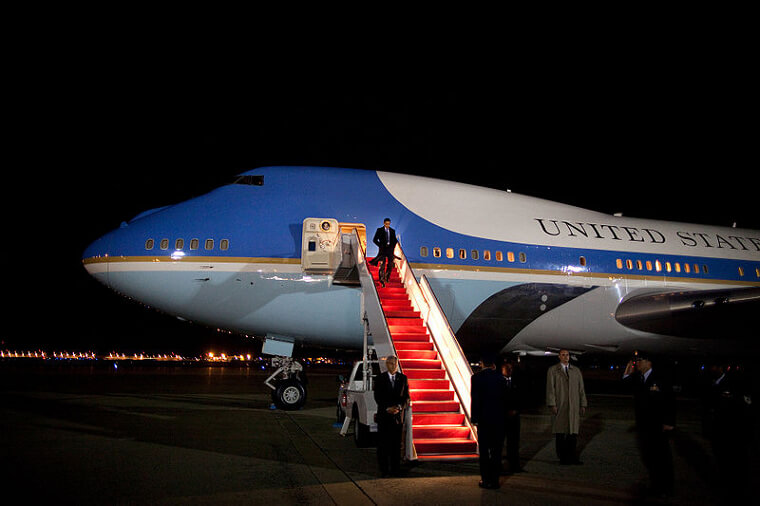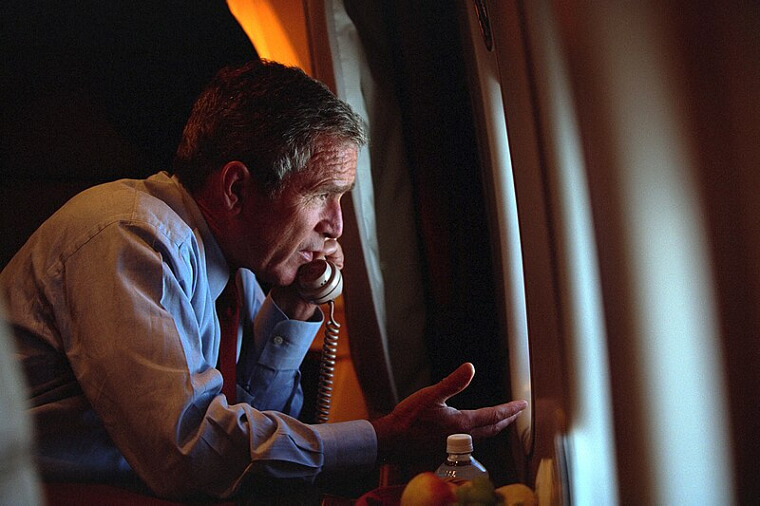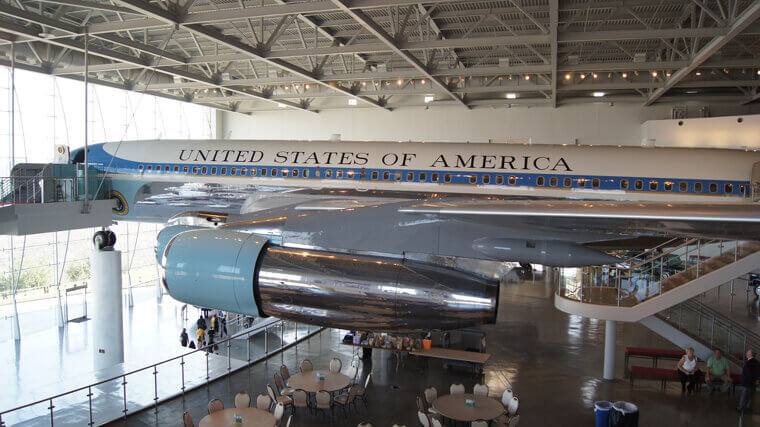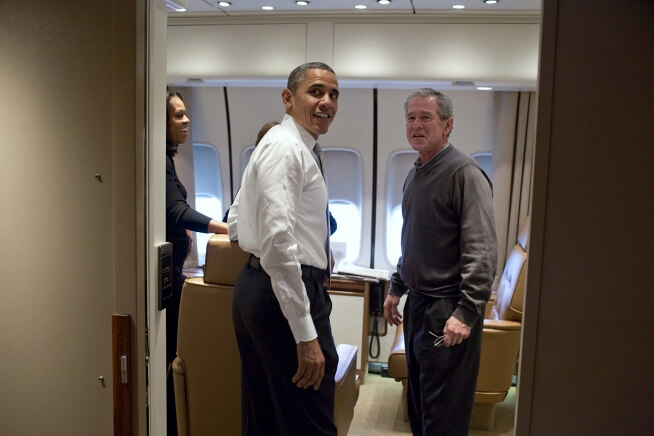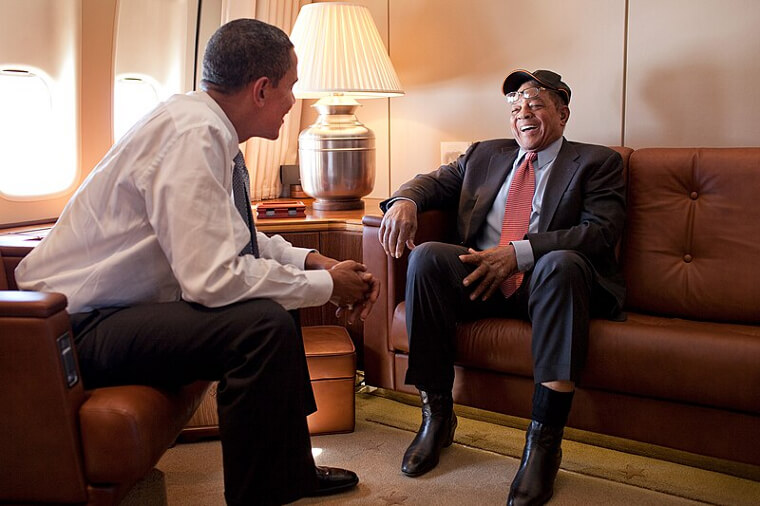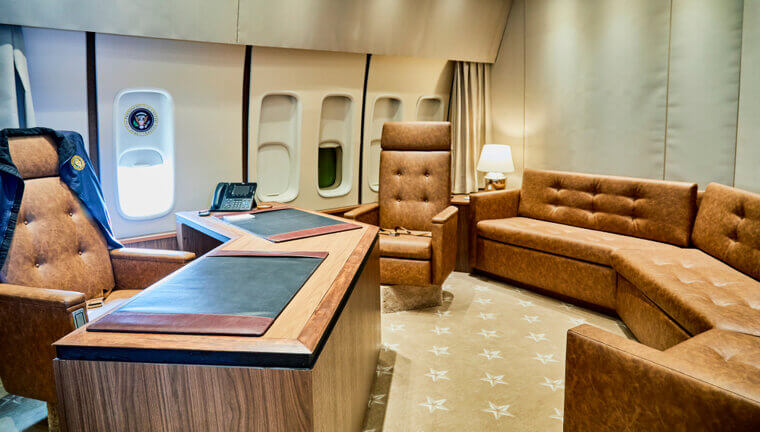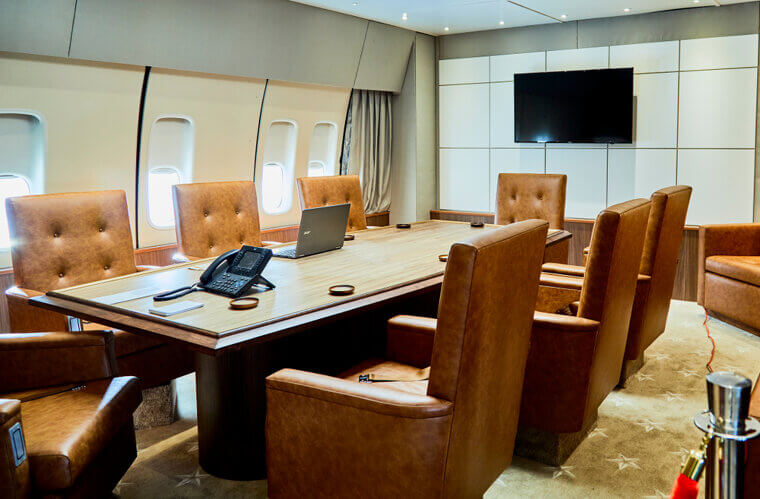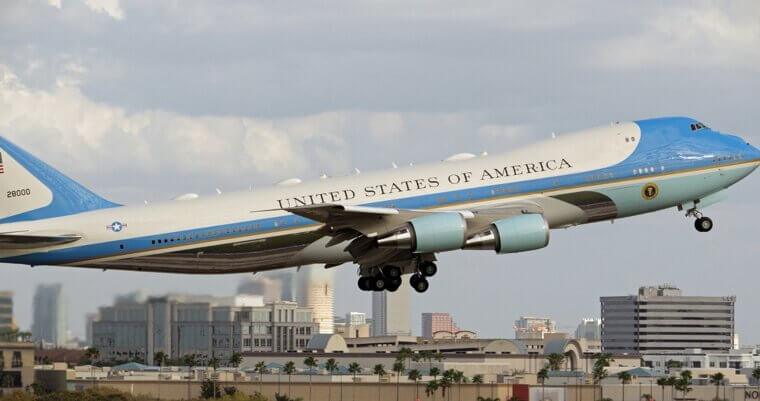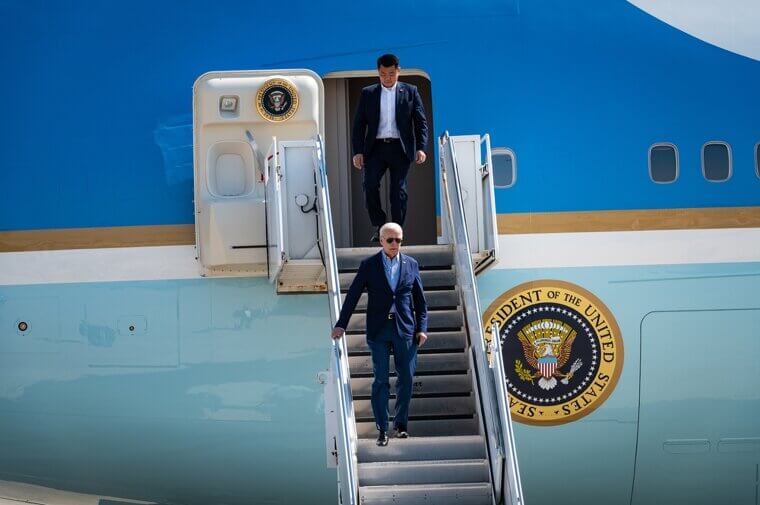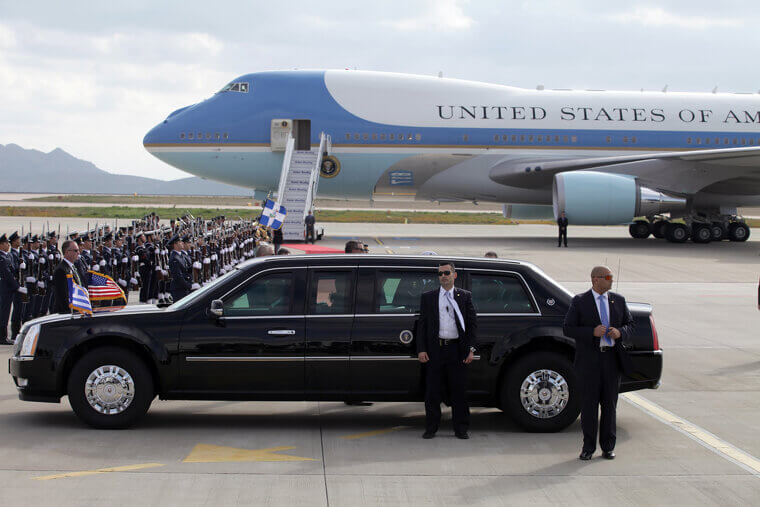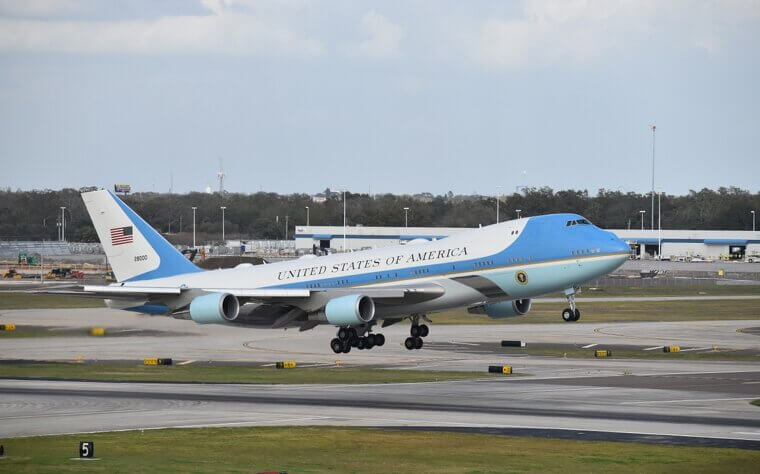Carry Decoy and Backup Luggage
The presidential security team is always looking for potential threats, but even the most highly trained professionals may overlook tiny details if they aren’t obvious threats. That’s why Air Force One carries decoy bags along with the president’s actual luggage: to reduce the risk of someone tampering with it or attempting to steal something. This also provides more peace of mind for the team onboard when items are loaded onto the aircraft.
To ensure total safety, Air Force One must consider even the smallest potential risks. This means guarding and inspecting the cargo as thoroughly as the rest of the aircraft’s parts and controls.
Follow Strict Noise Protocols During Landings
Though everybody knows that Air Force One is the official aircraft of the President of the United States, that doesn’t mean the team wants to draw attention to it. When landing, the aircraft adjusts its engines and landing approach to minimize noise, particularly in residential areas that the crew may be unfamiliar with. It’s essential that they are prepared for anything, so landing as quietly as possible makes the job much easier and safer.
These strict noise protocols benefit the people living nearby as much as they do Air Force One. They reduce disturbances that may confuse or panic people, helping to maintain a calm environment for landing and disembarking.
Be Prepared for Submarine Coordination
The general rule when flying Air Force One is to be prepared for anything, but did you know that that includes coordinating with submarines? Naval vessels are constantly on the lookout for national security threats, so they may need to supply information to the president during flight. Similarly, if something happens in the air, Air Force One may need to coordinate with submarines to arrange landing and continue guarding the president's safety no matter where they are.
Planes and submarines can typically communicate using radio transmissions, so Air Force One employs similar, high-quality technological equipment for efficient and smooth coordination throughout the journey.
Use Decoy Planes
Sometimes, the president must fly even when threats are present, so Air Force One has a very important job. The president's flight plan will be kept top secret, but the work to deter dangers doesn't end there. To confuse threats in the air, Air Force One will travel with an identical decoy plane. This disguises the president's current location, reducing the risk that anybody will strike, as the attempt may fail.
Like the rest of the fleet, the decoy plane will also monitor issues during flight. The planes are strategically positioned to further confuse any threats and maintain their decoy status until the president has landed and disembarked.
Crew Must Be Military Trained
Air Force One is a military aircraft, so it only makes sense that all of the staff onboard are highly trained military personnel. The pilots, flight attendants and other staff must all know how to deal with situations on a military level because there are massive stakes involved in transporting the country's leader. They must also be able to carry out military-grade inspections and understand the codes and coordination involved in arranging communication during flight.
A highly-trained military crew ensures that all members of staff can handle the pressure of the job because one mistake could quickly become a very serious situation for everybody involved.
Fly at Higher Altitudes Than Commercial Aircrafts
Air Force One typically avoids commercial flight paths altogether, but it also flies at higher altitudes for safety purposes. The aircraft can fly up as high as 45,100 feet! There is a lot of traffic on commercial air routes that often causes backlogs that lead to delayed landings. It is Air Force One's job to get the president to their destination as quickly and efficiently as possible, so favoring higher altitudes avoids disruption and maintains privacy.
Flying at commercial altitudes also unnecessarily exposes Air Force One to potential threats, so it's best to keep to its own routes. The Air Force One aircraft will be able to manage higher altitudes without issue.
Install Advanced Anti-Missile Technology
As a military plane, Air Force One is equipped with all the best defensive technology and infrastructure. This includes advanced anti-missile technology, which is used to counteract both air-to-air and ground-to-air attacks. The infrared countermeasures divert incoming missiles by masking the heat of the aircraft’s engine and creating flares, misleading the missile as to where its intended target is. The anti-missile technology is able to detect airborne missiles and then immediately employ defensive measures.
Firing a missile at Air Force One is an act of war declared against the president. The anti-missile modifications would successfully divert the missile, but it would be a terrifying moment in American history.
Carry Medical Equipment and a Doctor
In the event of a medical emergency, it isn't always possible to safely arrange a swift landing. And even then, the emergency may be so severe that there is no time to wait until the plane lands. That's why Air Force One always carries medical equipment and a doctor to attend to any passengers, but especially the president. There is a dedicated medical suite onboard that can be used as a temporary hospital room until the plane has landed.
Like with pilots and other crew members, there are several highly-trained physicians available to be selected for Air Force One flights. They are equipped with all the essential skills and tools required to administer medical treatment.
Passengers Must Be Weighed
Though all aircraft must consider onboard weight, knowing the exact amount on Air Force One is vital. To obtain this information, all passengers, including crew, government officials, and even the president, must be weighed before they come onboard. This increases the flight's efficiency and settles any safety concerns about the onboard weight being too much. The weight of luggage, bags, gifts, and other items is also taken into account.
Air Force One has a passenger capacity of 102 people and a maximum takeoff weight of 833,000 pounds, though the actual numbers and weight onboard are far less for comfort and safety.
Travel With Emergency Escape Pods
Emergency escape pods on planes may sound like something out of an action movie, but they’re supposedly very much real on Air Force One! The aircraft is designed for extreme situations, so provisions are made for every eventuality. In an emergency, the president can be evacuated from the aircraft via an escape pod, which would seal them in and return them safely to the ground. This rule is based on speculation, however, mainly due to pop culture.
The 1997 movie Air Force One featured an escape pod scene, so it’s a highly popular rumor that the real-life aircraft also travels with one. However, as the public, we may never know for sure!
Must Be Ready For Mid-Air Refueling
Despite its 7,800 statute miles of range, Air Force One may need to be refueled during long journeys, trips with multiple stops, or in an emergency. The tank should be full when the aircraft takes off, and it also carries extra reserves to supplement that. However, it may become necessary to refuel during a flight. This is done via aerial refueling, with an accompanying tanker aircraft transferring fuel mid-air through a receptacle.
The mid-air refueling process usually takes around 10 minutes, and Air Force One continues flying undisturbed throughout! Once it has been refueled, the tanker aircraft withdraws, and the flight continues as usual.
Have an Encrypted Emergency Signal System
Though Air Force One is fitted with many technological safety measures, it may still end up in an emergency that it can’t escape on its own. In these circumstances, the emergency signal system will be used to send coded signals to military bases. These signals are encrypted so that the people receiving them can understand what is being said while protecting the information from any outside threats. That’s why it’s so important for Air Force One’s communications systems to be well-maintained.
The encrypted emergency signals sent out may request backup from other military assets or warn of any big threats. The military then works together to formulate a response and protect the president.
Equip With Advanced Recon Technology
Air Force One’s main job may be to carry the president, but it’s more than just a mode of transportation. The aircraft is fitted with advanced recon technology, which allows it to gather intelligence while airborne. This information helps the crew understand the environment of their flight path and screen out any potential threats to the aircraft. Surveillance tools look out for any possible risk, giving pilots more insight into and control over their journeys.
If the recon technology shows something that could delay or otherwise disrupt the route, the crew can then plan ahead. They may need to divert the aircraft or lengthen the journey if it means keeping the president safe.
Carry Portable Nuclear Codes
Aside from the president, Air Force One is tasked with transporting the most important thing in the United States: the nuclear football. Despite its fun-sounding name, the nuclear football is actually the Presidential Emergency Satchel. It contains portable codes that allow the president to authorize and launch a nuclear attack while on the move. The Air Force One command center gives the president somewhere to stow the nuclear football safely.
The portable nuclear codes inside the briefcase have the potential to start a nuclear war, so they must be fiercely protected from any potential damage or interference during transportation.
Carry Portable Desalination Equipment
There are plentiful food and drink reserves provided on Air Force One, but there may be circumstances when those stores run out. Water, in particular, is crucial to survival, so in extended emergencies, Air Force One will use portable desalination equipment to produce potable drinking water. This may mean purifying seawater via reverse osmosis, using advanced technology to produce drinkable liquids for everybody onboard. Through this process, thousands of gallons can be safely converted.
The process of desalination also ensures that any contaminants are flushed out of the water before it is consumed. Many military aircraft and ships use this process to keep the crew hydrated in emergencies.
Undergo Special Weather Analysis by Meteorologists
Weather conditions are one of the greatest threats to any flight, so even though Air Force One must be prepared to fly at short notice when necessary, special weather checks will be carried out to ensure conditions are safe for flight. Meteorologists analyze weather patterns, including the wind, to determine visibility, speed, and stability. In the case of poor weather, alternate flight paths will be considered to avoid taking risks.
In addition to safety, Air Force One prioritizes efficiency, so if one route has weather advantages over all others, it will be selected.
Presidential Food Is Pre-Screened
If somebody wishes to harm the president at any point during the flight and cannot tamper with the safety of the plane, they may target the food onboard instead. To avoid this risk, all food that the president will consume is thoroughly inspected and then made into meals by trusted staff members. On a longer journey, the president may be served multiple meals, so it's vital that all contamination, malicious or otherwise, is avoided.
There is security everywhere, both on and off the aircraft, so not even staff can get away with food tampering. If there are any worries about its safety, the food will not be served onboard.
Run on Custom Fuel
Air Force One may look like any other plane on the outside, but things are very different on the inside. To keep the aircraft operating at maximum speed and efficiency, it uses a high-grade military fuel called JP-8. This fuel is kerosene-based and is used in all US military aircraft. This custom fuel enhances the jet’s performance and reduces the risk of something going wrong with the fuel mid-flight. The aircraft also has a massive fuel capacity so that it can make long journeys with this fuel.
In circumstances when Air Force One cannot be militarily refueled, it may be filled with a different type of fuel provided by civilian facilities. Though they aren’t at the same level, commercial aircraft fuels also work in Air Force One.
Protect Against EMPs
Electromagnetic pulses, commonly known as EMPs, are small bursts of energy that can cause huge damage to electrical equipment. If an EMP hits a plane while in the air, the result could be catastrophic. Aircraft equipment can be tested with EMPs to determine its structural resistance, which has actually helped engineers create electronics for Air Force One that protect against EMPs. All equipment is hardened to shield the aircraft from pulses produced by the sun or nuclear attacks.
This detail in the production of Air Force One’s electronics may seem small, but without this defensive technology, the plane could drop out of the sky if even one EMP penetrates the aircraft!
Always Land First at Airports, Even if It Disrupts Other Flights
As the president’s official aircraft, there are some rules that permit special treatment for Air Force One. The aircraft will always land first at airports, even if there are other flights due beforehand. As the most important aircraft in the United States, it takes precedence over all other planes during departures and arrivals. The president may need to be somewhere else in a short amount of time or be swiftly evacuated in the event of threats to their safety.
Air Force One is not just a plane; it’s an entire military-grade operation. By always landing first, it maintains the utmost security while aiming to cause minimum delays to commercial flights.
Coordinate Closely With Marine One
Marine One refers to any United States Marine Corps aircraft, usually a helicopter, that is carrying the president, and it works closely with Air Force One. The two have very similar and intrinsically linked logistics, protecting the president's safety and security every time they are in the air. Ground-to-air maneuvers involve many strict rules, and Air Force One may take the lead and provide input and support for Marine One.
Like with Air Force One, the Marine One call sign is only used when the president is currently onboard. Otherwise, the aircraft is just another Corps helicopter, though it must be prepared for whenever the president needs it.
Avoid Commercial Flight Paths
Air Force One is not a typical aircraft, so it doesn’t follow typical flight paths. While commercial flights are bound by the conditions relating to those flight paths, Air Force One charts exclusive routes to reduce the risk of any interference or delay that could seriously compromise the president’s safety. Air Force One is responsible for getting the president to places on strict time, so any setbacks can have serious consequences that don’t exist for commercial flights.
Despite its security, Air Force One’s flight path is not a secret. Anyone can track it like they can a commercial flight, but it is rarely spotted taking the same route as other planes.
Operate With Dual Pilots at All Times
All flights will have a pilot and co-pilot, but with Air Force One, having two pilots is non-negotiable. Both pilots are required to be present and alert throughout the flight to ensure somebody is always ready to handle the jet should any issues arise. One pilot may have an emergency and be unable to continue their duties, so the second pilot can step in and take control, ensuring a safe journey and landing for all on board.
Only the best pilots are handpicked to fly Air Force One when the president is on board. Though there are plenty to choose from, all have expert flight training.
Always Have a Backup Plane Ready
Air Force One never flies alone, and provision is made for every scenario, particularly those that may occur in the air. That's why a backup plane follows the actual aircraft in case of an emergency. If the president needs to be evacuated from the plane because of a threat or any mechanical failures during the flight, they can board the backup jet and continue to their location. Two Boeing 747-200Bs are used to ensure that both planes are equally efficient and capable.
The backup plane can also provide logistical support during flight and is in constant communication with the jet carrying the president. The entire fleet works together to make the journey as easy as possible.
When the First Lady Is on Board, It's Called “Air Force Two”
We tend to refer to an aircraft that is used to transport the President of the United States as “Air Force One” by default, but that name actually only applies when the president is onboard. For any other journeys, the plane is no different than any other military aircraft, so it doesn't receive any special treatment while flying. The radio call sign becomes “Air Force One” again when it is used for presidential business once more.
When the Vice President or First Lady of the United States is onboard, the call sign is “Air Force Two”, which signals a similar level of respect but reserves Air Force One for the president alone.
Always Have Military Escorts Nearby
Air Force One is part of a fleet, with many aircraft protecting the security of the one carrying the president. If a flight is deemed to be high-risk, fighter jets will accompany it to provide military support if anything goes wrong. These fighter jets can engage in air combat, though they will not be used unless a serious threat to the president’s safety becomes apparent. They mostly look out for potential issues and keep tabs on Air Force One.
If a situation arises when fighter jets must be used, Air Force One focuses on evacuating the president from the airspace as soon as possible, fulfilling its primary role of protecting the president.
Must Be Ready to Fly at Anytime
The President of the United States is the most important person in the country, so must be able to attend to important national and international business at any time. This means relying heavily on Air Force One to provide the necessary transport in the quickest and most efficient way. The aircraft is kept in a constant state of readiness, with a full fuel tank and all systems checked and set. This allows for prompt take-off at a moment’s notice.
Due to the high risks always present for the president, Air Force One aircraft may be needed with little notice, so it’s essential that they are manned and prepared for anything.
Keep Maintenance Details Confidential
Due to its important job, Air Force One is possibly the most well-maintained aircraft in the United States. Even the smallest problems must be closely inspected and swiftly repaired to ensure the jet is ready to go whenever it is next needed. However, all details relating to any repairs or modifications are kept classified because of the risk of interference if the information is leaked to people wishing to harm the president.
Confidentiality is one of the most important factors in arranging and manning Air Force One flights, so everyone involved is bound by strict secrecy regulations to maintain safety and security.
Prohibit Public Tours
Many of the public are excited to see real-life military vehicles, but while other military planes offer public tours, Air Force One is strictly off-limits for viewing when in active use. This is because the aircraft may be needed for important presidential business at any moment, so a tour would delay take-off. Opening up the most essential military vehicle in the country to public viewing could also lead to tampering or interference, so it's safer to keep Air Force One restricted to only the most important personnel.
You can visit many Air Force One recreations and old aircraft no longer used to transport the president, so even though the current service prohibits public tours, you don't have to miss out!
Carry Classified Documents
Air Force One is a lot more than just a plane. It transports classified documents along with the president and serves as a mobile command center for official business conducted while in the air. The plane stores this important information securely, protecting against any leaks to the public. Only those closest to and most trusted by the president are allowed onboard to witness or be involved with classified documents and any meetings conducted.
Air Force One is essentially an airborne version of the White House office. It has quarters for the president to sit in and conduct business as necessary.
Undergo Pre-Flight Airfield Inspections
The president may be targeted by threats before they have even boarded Air Force One, so the security team will conduct intensive inspections of the airfield before the flight is boarded. The same checks of the runway and surrounding areas will be carried out before landing, too. Anything that may interfere with the safety of take-off or landing must be removed, or else the flight will be delayed or diverted as necessary.
All pre-flight airfield inspections are typically completed before the president arrives. This ensures that they can board as soon as they arrive at the airfield and settle in for the journey without disruptions.
Conduct In-Flight Security Checks
Even after the aircraft and airfield have been thoroughly vetted before the president boards the plane, Air Force One maintains strict security protocols throughout the flight. This means conducting in-flight security checks to sweep the entire aircraft for threats. If one is discovered, the crew will immediately work to arrange an emergency landing and communicate with any other necessary personnel in the air and on the ground. During long journeys, multiple checks will be conducted.
Until the plane touches the ground safely and the president has exited, threats are assumed to exist. Crew are constantly alert and pay attention to any small change while in the air.
Maintain Communications at All Times
One of the most important technologies onboard an Air Force One flight is the communication system. The pilot and crew are constantly in contact with global military and government leaders and the rest of the fleet around the main aircraft. Air Force One uses a secure, uninterrupted line of communication to relay all important information and request assistance if necessary. Everybody involved must be alert and ready to receive calls.
If communications on Air Force One go down during flight, the crew will work to get them back up as soon as possible. If they suspect tampering, the aircraft may make an emergency landing.
Use False Flight Numbers When Necessary
All planes have flight numbers, including Air Force One, but this important aircraft is allowed to use false flight numbers without penalty when necessary. For example, if a threat is suspected, the plane will be assigned a generic flight number to obscure its identity. This means that only those closest to Air Force One will be aware that it is flying that day, maximizing security until the president has been safely transferred from one location to another.
When Air Force One operates under a false flight number, it will still show up on plane tracking sites, but as any generic flight so as not to draw attention.
No Identifying Tail Numbers
Once produced, every plane is assigned a registration number, which is usually located on the tail. Even private jets aren’t exempt from this rule, yet it doesn’t apply to Air Force One. Standard tail numbers can be used to track flights, which isn’t a problem unless the President of the United States is onboard and conducting official state business. Removing identifying tail numbers is one of the simplest ways to increase security.
In the past, Air Force One did fly with tail numbers, but they have since been removed because they pose an unnecessary risk to the president’s safety during transit and may draw unwanted attention to the flight path.
Stay Within US Military Airspace When Possible
Air Force One is dedicated to the president’s every travel need, which means flying them wherever they need to go. However, the aircraft must stay within US military airspace when possible, which has the advantage of a controlled airspace that the crew is familiar with. The US military airspace is strong, so there’s plenty of protection available for every flight Air Force One takes. However, when it isn’t feasible to remain within US airspace, Air Force One will take international flight paths.
The rules for entering another country’s airspace differ depending on the type of aircraft, so Air Force One will be permitted to do so when the president is flying internationally on official business.
Always Follow a Pre-Screened Route
The biggest potential threats to a presidential flight crop up when the plane is in the air, so Air Force One must always follow a pre-screened route to reduce the risk of anything going wrong. Every step of the journey is carefully planned to avoid any conflicts and ensure a smooth journey through the air. Experts will pre-screen things like the weather and other aircraft taking flight at the same time to ensure there are no disruptions on Air Force One’s flight path.
However, even with careful pre-screening procedures, there may be circumstances when Air Force One must divert from its intended route, particularly if a weather or threat is detected. Safety is always the first priority.
Avoid Flying Over Highly-Populated Areas When Possible
People who catch a glimpse of Air Force One flying overhead in cities are often surprised because it’s rare to see. Whenever possible, Air Force One avoids flying over highly populated areas, like major cities, to minimize security risks and protect the privacy of the flight path. In the past, Air Force One has been seen flying over busy areas for training exercises or photo ops, but there is always the chance that seeing the fleet will cause panic.
Even when carrying the president, Air Force One remains a military aircraft, so it must adhere to military rules. Flying over busy cities could cause confusion, noise pollution, and unnecessary exposure.
Keep the President’s Schedule Confidential
Air Force One is privy to the president’s schedule because it is responsible for getting them to important places on time, but it’s vital that this sensitive information isn’t leaked to the public. Only a select few people know the president’s schedule, which helps to reduce the risk of somebody attempting an attack on one of the places they visit. The itinerary is tightly guarded, and the crew is restricted from speaking about it, too.
Air Force One does all it can to mask its presence in the skies, but its work begins before a flight has even been arranged. Routes are pre-scheduled and pre-screened, and everyone involved must maintain utmost discretion.
Undergo Background Checks for All Maintenance Workers
Pilots may be responsible for ensuring the president has a safe flight, but it’s all of the maintenance workers responsible for fixing the aircraft who make this possible. That’s why every technician, engineer, or contractor employed to work on Air Force One must undergo an extensive background check. If anything crops up that suggests the worker may have bad intentions or not be up to the job, they will not be contracted to work.
Air Force One is treated with extreme caution, and its maintenance makes it possible for the president to get around so easily. Vetting everybody who goes near the aircraft is a big part of the security process.
Maintain Decoy Landing Schedules
Air Force One doesn’t always use false landing schedules, but they may be employed if publishing the real itineraries is deemed a great risk. Decoy landing schedules may list different departure and landing times and alternate locations to the president’s actual destinations. This is an easy way to maintain secrecy and ensure the president can travel with peace of mind in uncertain circumstances. Threats may be confused or diverted entirely.
When maintaining decoy landing schedules, Air Force One must be smart so as not to draw attention to the falsified information. That way, the aircraft can fly under the radar without anybody questioning it.
